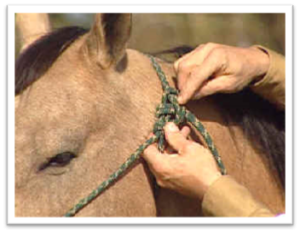1.3 Training
Horse Vision
Horses can see almost completely around themselves, especially if their head is down. Horses will bring their head close to the ground if they are unsure of footing.
Horse eyes are among the largest of any land animal.
- The eyes are positioned on the sides of the head.
- Horses have a range of vision of about 350° with 65° of this vision is from both eyes and the remaining 285° from one eye or the other.
Horses do have blind spots, though, where they are not able to see. The horse’s blind spots include:
- under the jaw
- in the front of the forehead
- directly behind them
Avoid blind spots and startling the horse by always talking to the horse as you are approaching and coming from a spot that the horse can see you.
Feedyard Horses
The feedyard is not the place to start training a young horse. Horses should come onto the yard being able to:
- Work calmly around cattle and other horses.
- An aggressive or scared horse is a dangerous horse.
- Open gates – side pass from both sides.
- Stand quietly while tied.
- Stand quietly while having their feet worked on.
Do you know of cowboys / cowgirls who have been injured or killed while working with horses on the feedyard?
Horse’s Reaction Time
- Stand close enough to a horse to have direct contact (hand on the horse) or far enough that they can’t reach you.
- Stand by the shoulder and move around the horse keeping contact all the way around.
- Struck by the horse’s front feet, either from standing position or by rearing up.
- Struck by the horse with their back legs. Horses can kick straight back either with one leg or both legs. They can also cow kick to the side.
- A horse bite can be very destructive to a human. A horse can bite with as much as 300 pounds of pressure per square inch (psi), compared with a human bite of approximately 60-120 psi.
- Run over.
Remember that a horse can bolt and
cow kick on the way past.
Catching Your Horse
There are a few safety tips to keep in mind when catching your horse in the pen to move them or saddle them.
- Keep the horses head toward you when you are catching a horse. Do not approach a horse that has its face away from you.
- Make sure the horse knows that you are coming.
- Move to the horse’s head from the side of the horse to avoid being kicked.
- Once haltered, DO NOT wrap the lead rope around your arm or body.
Injuries
These injuries can occur when not handling the lead rope properly and your horse takes off quickly, jumps back, etc. :
- Hands can have rope burns and skin removed if lead ropes are looped around them.
- Handlers can be drug by the horse if ropes are secured around their body.
This Part 2 video (11 mins) demonstrates appropriate behavior around horses, selecting the right horse for the rider, using the right equipment and haltering a horse. Produced by: SW Ag Center (http://www.swagcenter.org), University of Texas Health Science Center at Tyler, Texas A&M University, Texas AgriLife Extension, LSU Ag Center, University of Arkansas Division of Extension, New Mexico State University Cooperative Extension Service, Southern Plains Animal Hospital, CDC/NIOSH Cooperative Agreement #U50-OH07541
Review
Work through these interactive questions to review the important concepts discussed.
Areas around a horse that it cannot see due to the positioning of its eyes. These spots are directly in front of the forehead, directly behind, and under the jaw. It's important to avoid approaching a horse from these angles to prevent startling it.
A defensive kick performed by a horse, where it kicks out to the side with one or both hind legs. This type of kick can occur when a horse feels threatened or startled, making it essential to approach and handle horses carefully.
A rope attached to a horse's halter, used for leading or tying the horse. It is important to handle the lead rope properly to avoid injuries, such as wrapping it around your hand or body.


